
Aleuria aurantia is a widespread ascomycete fungus in the order Pezizales. The bright orange, cup-shaped ascocarps often resemble orange peels strewn on the ground, giving this species its common name.

Hypomyces lactifluorum, or the lobster mushroom, is a parasitic ascomycete fungus that grows on certain species of mushrooms, turning them a reddish orange color that resembles the outer shell of a cooked lobster. Contrary to its common name, the species itself is neither a mushroom nor a crustacean.

Pseudohydnum gelatinosum, commonly known as the toothed jelly fungus, cat's tongue, or jelly tooth, is an Eurasian species of fungus in the order Auriculariales. Its common names refer to its gelatinous consistency and hydnoid (toothed) undersurface.
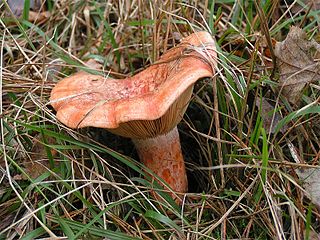
Lactarius deliciosus, commonly known as the delicious milk cap, saffron milk cap, or red pine mushroom, is one of the best known members of the large milk-cap genus Lactarius in the order Russulales. It is native to Europe, but has been accidentally introduced to other countries along with pine trees, with which the fungus is symbiotic.
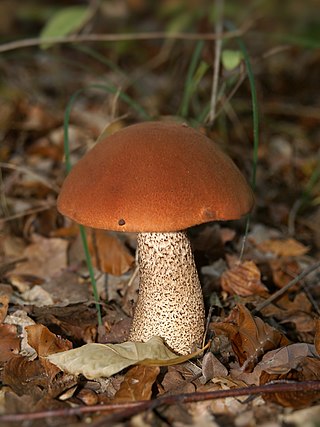
Leccinum aurantiacum is a species of fungus in the genus Leccinum found in forests of Eurasia and North America. It has a large, characteristically red-capped fruiting body. In North America, it is sometimes referred to by the common name red-capped scaber stalk. Some uncertainties exist regarding the taxonomic classification of this species in Europe and North America. It is considered edible, but must be cooked thoroughly.

Neolentinus ponderosus, commonly known as the giant sawgill, or ponderous lentinus, is a species of fungus in the family Gloeophyllaceae. Found in western North America, it was originally described in 1965 as a species of Lentinus by American mycologist Orson K. Miller.
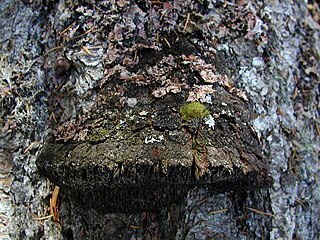
Echinodontium tinctorium, commonly known as the Indian paint fungus or toothed conk, is a species of fungus in the family Echinodontiaceae. It is a plant pathogen. Found on tree species such as grand fir.
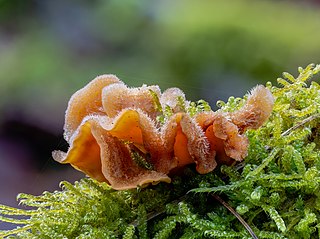
Stereum hirsutum, commonly known as the false turkey tail, hairy stereum, or hairy curtain crust, is a species of fungus and a plant pathogen that infects peach trees.
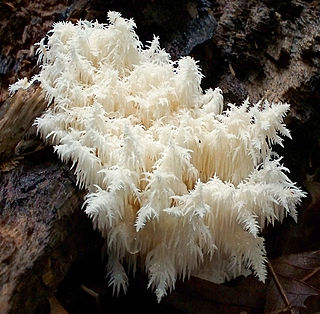
Hericium coralloides is a saprotrophic fungus, commonly known as coral tooth fungus or comb coral mushroom.

Cerrena unicolor, commonly known as the mossy maze polypore, is a species of poroid fungus in the genus Cerrena. This saprobic fungus causes white rot.

Bulgaria inquinans is a fungus in the family Phacidiaceae. It is commonly known by the names poor man's licorice, black bulgar and black jelly drops.

Humaria hemisphaerica is a species of fungus in the family Pyronemataceae. In the UK it has the recommended English name of glazed cup; in North America it has been called the hairy fairy cup or the brown-haired fairy cup. Ascocarps are cup-shaped and can be recognized by their smooth, white inner surface and hairy, brown outer surface. The species is ectomycorrhizal and occurs in Europe and North America.

Caloscypha is a fungal genus in the family Caloscyphaceae. A monotypic genus, it contains the single species Caloscypha fulgens, commonly known as the snowbank orange peel fungus, spring orange peel fungus, the golden cup, or the dazzling cup. It is a cup fungus, typically up to 4 centimetres in diameter, with a bright to pale orange interior and orange; specimens that are old or bruised often have an olive-green discoloration, especially around the edges.
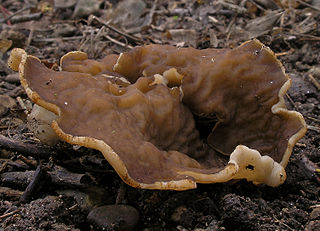
Disciotis venosa, commonly known as the bleach cup, veiny cup fungus, or the cup morel is a species of fungus in the family Morchellaceae. Fruiting from April, they are often difficult to locate because of their nondescript brown color.
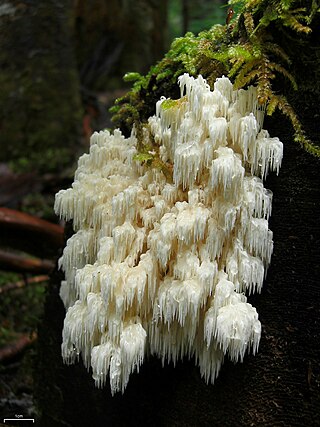
Hericium abietis, commonly known as the bear's head, conifer coral hericium, or western coral hedgehog, is an edible mushroom in the tooth fungus group. It grows on conifer stumps or logs in North America, producing a cream white fruit body up to 10–75 cm (4–30 in) tall and wide. It fruits from after the start of the fall rains to mid-season.
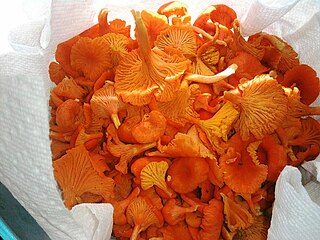
Cantharellus cinnabarinus, the red chanterelle, is a fungus native to eastern North America. It is a member of the genus Cantharellus along with other chanterelles. Its distinctive red color is imparted by the carotenoid canthaxanthin. It is considered edible and good, fruiting in association with hardwood trees in the summer and fall.
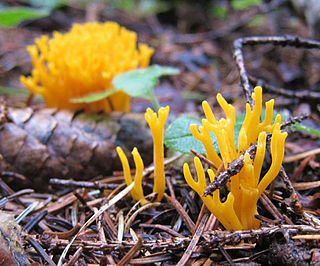
Calocera viscosa is a species of fungus in the family Dacrymycetaceae. In the UK, it has the recommended English name of yellow stagshorn. In North America it is variously called coral jelly fungus, jelly staghorn, yellow false coral, yellow tuning fork, and jelly antler. Basidiocarps are gelatinous, bright golden yellow, and branched. It grows exclusively on logs and dead wood of conifers. Calocera viscosa is a common species throughout Europe and has also been recorded from North America, Asia, and Australia.

Guepiniopsis alpina, commonly known as the jelly cup, alpine jelly cone, or poor man's gumdrop, is a species of fungus in the family Dacrymycetaceae. The small, gelatinous fruit bodies are orange and cone- or cup-shaped. Found in western North America, Sweden and Iran, the fungus grows on decaying conifer wood.

Helvella vespertina is a species of fungus in the family Helvellaceae.

Phaeocalicium polyporaeum, the fairy pin or common pin, is a species of non-lichenized fungus in the genus Phaeocalicium. They grow to a maximum size of 2.5 mm and resemble black matchsticks, with thin stalks and wider caps, in groups or rows primarily on the caps of Trichaptum biforme. Fairy pins are a type of parasitic fungi that grow primarily on the caps of Trichaptum biforme, but have also been reported on Trametes versicolor. They often co-occur on the upper side of caps with green algae on host fungi.




















